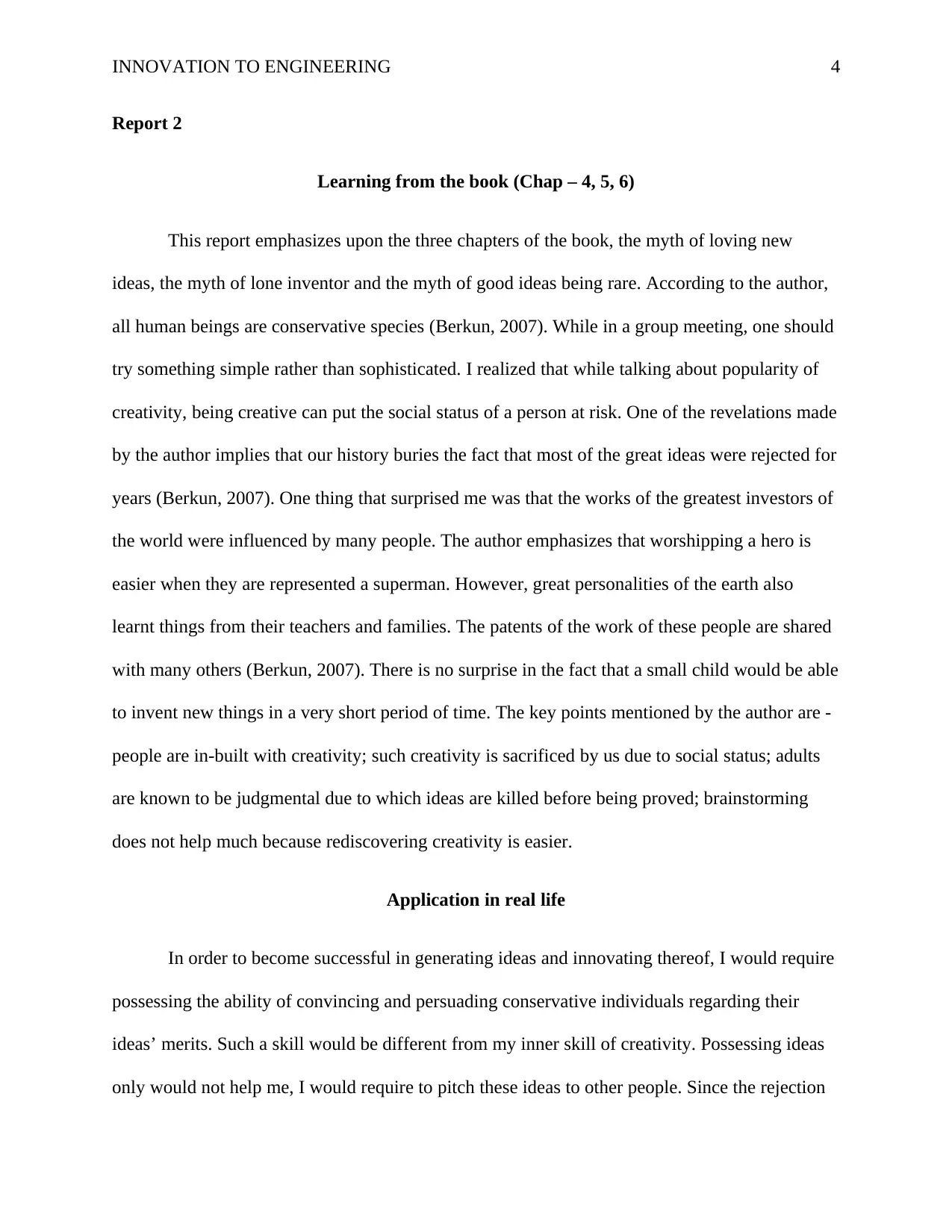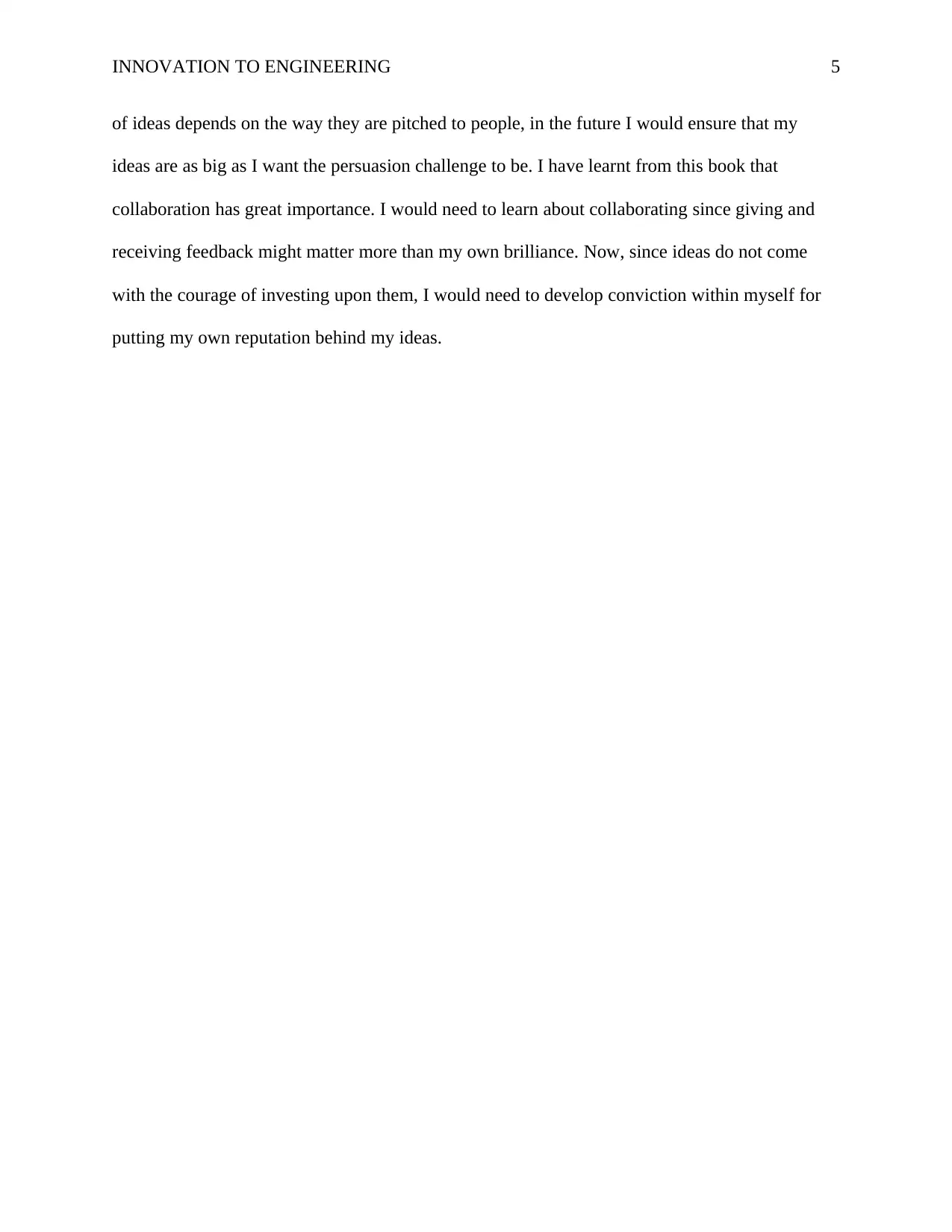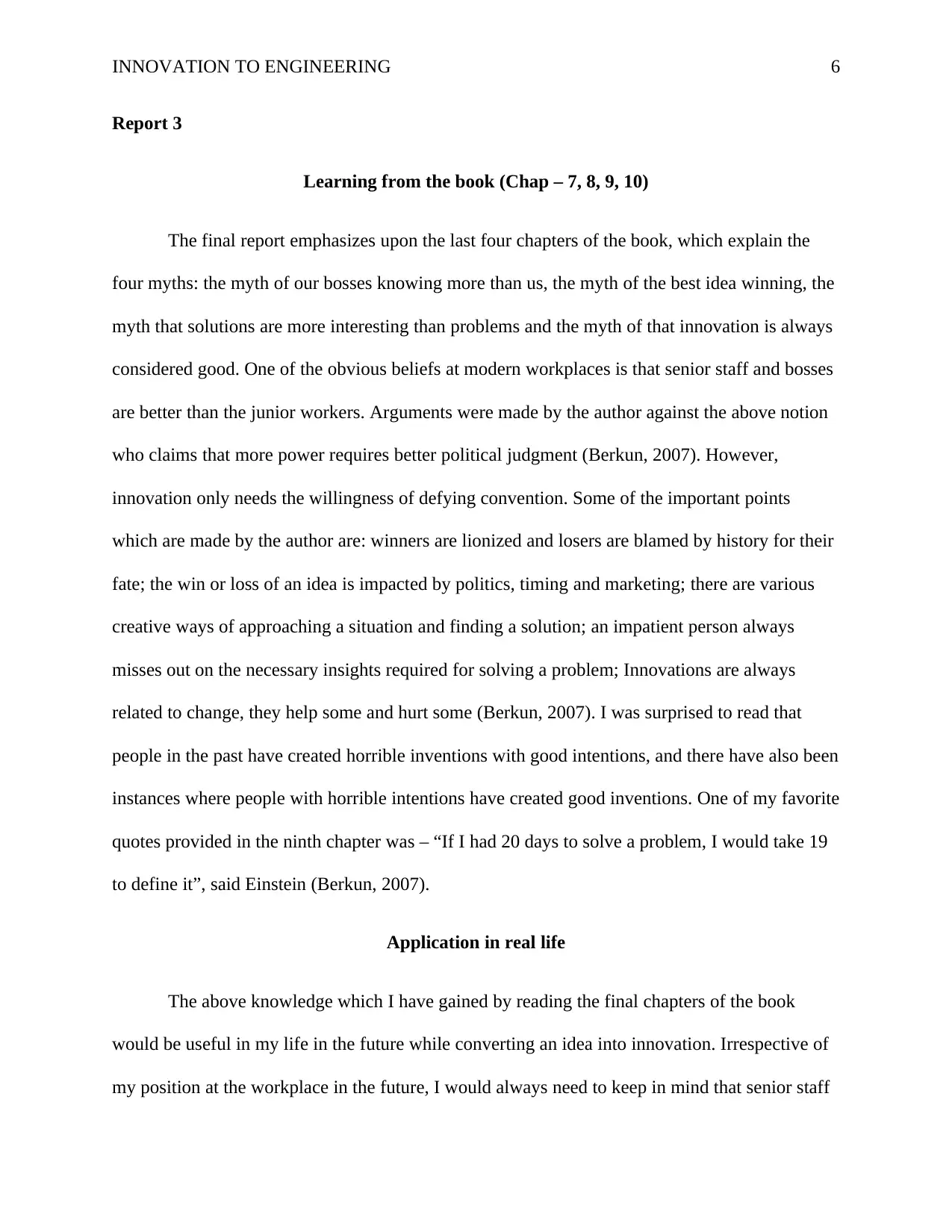Detailed Book Report: Innovation to Engineering - EMS2ITI Course
VerifiedAdded on 2023/04/07
|8
|1322
|465
Report
AI Summary
This assignment comprises a three-part book report focusing on 'The Myths of Innovation' by Scott Berkun. The reports cover chapters 1-3, 4-6, and 7-10 respectively, delving into myths such as the epiphany myth, the myth of the lone inventor, and the myth of innovation always being good. Each report summarizes the key learnings from the assigned chapters and reflects on their real-life applications, particularly in the context of converting ideas into innovations. The student analyzes how epiphanies are both an inspiration and outcome of effort, the importance of collaboration, and the need to understand the political landscape surrounding innovation. The report also emphasizes critical thinking about commonly held beliefs in workplaces and the importance of problem definition. The student reflects on how the insights gained can be applied to their future endeavors, stressing the importance of persuasion, collaboration, and understanding the potential consequences of innovation. This resource is available on Desklib, a platform providing study tools and assignments for students.

Running Head: INNOVATION TO ENGINEERING 1
Innovation to engineering
Innovation to engineering
Paraphrase This Document
Need a fresh take? Get an instant paraphrase of this document with our AI Paraphraser

INNOVATION TO ENGINEERING 2
Report 1
Learning from the book (Chap – 1, 2, 3)
In this part of the book, I learnt about the first three chapters which were regarding the
epiphany myth, the myth of the fact that we know history and the myth of method. I was able to
learn that there have been many epiphanies experienced by people which came to an end after
long term failure. I recalled that we all love insight flash stories which dominate the reporting of
our creativity. I was surprised to know from the book that certainty illusions are projected by
stories of epiphany as they are usually related to triumphant ideas. One of the important aspects
of life which I learnt was that the past is often romanticized by us for fitting into the present
(Berkun, 2007). As such, our creativity gets trapped since we are unaware of the chaotic history
of our on field. Another key fact provided by the author is that in a marketplace, one of the
biggest challenges with creative work is the number of factors which are usually beyond our
control. A shocking yet obvious revelation made by the author was that big promises are made
by most books about creativity on the basis of history (Berkun, 2007). Instances from the past are
picked by them which are then claimed to be predictive. As such, terms like innovation pipeline
and system become ridiculous.
Application in real life
From the first three chapters of this book, I learnt that epiphanies are not only an
inspiration for effort but also an outcome of the same effort (Berkun, 2007). Some questions
which arose in my mind were the amount of time spent by the creator in working before a flash
of insight takes place, and the amount of work done by them afterwards for making the idea
successful. In future, while converting an idea into innovation, I would keep in mind that would
Report 1
Learning from the book (Chap – 1, 2, 3)
In this part of the book, I learnt about the first three chapters which were regarding the
epiphany myth, the myth of the fact that we know history and the myth of method. I was able to
learn that there have been many epiphanies experienced by people which came to an end after
long term failure. I recalled that we all love insight flash stories which dominate the reporting of
our creativity. I was surprised to know from the book that certainty illusions are projected by
stories of epiphany as they are usually related to triumphant ideas. One of the important aspects
of life which I learnt was that the past is often romanticized by us for fitting into the present
(Berkun, 2007). As such, our creativity gets trapped since we are unaware of the chaotic history
of our on field. Another key fact provided by the author is that in a marketplace, one of the
biggest challenges with creative work is the number of factors which are usually beyond our
control. A shocking yet obvious revelation made by the author was that big promises are made
by most books about creativity on the basis of history (Berkun, 2007). Instances from the past are
picked by them which are then claimed to be predictive. As such, terms like innovation pipeline
and system become ridiculous.
Application in real life
From the first three chapters of this book, I learnt that epiphanies are not only an
inspiration for effort but also an outcome of the same effort (Berkun, 2007). Some questions
which arose in my mind were the amount of time spent by the creator in working before a flash
of insight takes place, and the amount of work done by them afterwards for making the idea
successful. In future, while converting an idea into innovation, I would keep in mind that would

INNOVATION TO ENGINEERING 3
need to invest time, make prototypes, face rejection and find investors without having the
guarantee of succeeding. I would need to use ancient tactics for changing the present. Finding a
great idea in my own field and working hard on it would help me largely in my daily life. I was
able to gain an insight that I would need to use certain methods which are useful and at the same
time would accept that the past and the present are different (Berkun, 2007). I would emphasize
more upon using ideas of innovation portfolio; as such ideas would be more honest because they
would assume a range of risks. I would also keep in mind not to use creativity related books
which are unreal and uncreative.
need to invest time, make prototypes, face rejection and find investors without having the
guarantee of succeeding. I would need to use ancient tactics for changing the present. Finding a
great idea in my own field and working hard on it would help me largely in my daily life. I was
able to gain an insight that I would need to use certain methods which are useful and at the same
time would accept that the past and the present are different (Berkun, 2007). I would emphasize
more upon using ideas of innovation portfolio; as such ideas would be more honest because they
would assume a range of risks. I would also keep in mind not to use creativity related books
which are unreal and uncreative.
⊘ This is a preview!⊘
Do you want full access?
Subscribe today to unlock all pages.

Trusted by 1+ million students worldwide

INNOVATION TO ENGINEERING 4
Report 2
Learning from the book (Chap – 4, 5, 6)
This report emphasizes upon the three chapters of the book, the myth of loving new
ideas, the myth of lone inventor and the myth of good ideas being rare. According to the author,
all human beings are conservative species (Berkun, 2007). While in a group meeting, one should
try something simple rather than sophisticated. I realized that while talking about popularity of
creativity, being creative can put the social status of a person at risk. One of the revelations made
by the author implies that our history buries the fact that most of the great ideas were rejected for
years (Berkun, 2007). One thing that surprised me was that the works of the greatest investors of
the world were influenced by many people. The author emphasizes that worshipping a hero is
easier when they are represented a superman. However, great personalities of the earth also
learnt things from their teachers and families. The patents of the work of these people are shared
with many others (Berkun, 2007). There is no surprise in the fact that a small child would be able
to invent new things in a very short period of time. The key points mentioned by the author are -
people are in-built with creativity; such creativity is sacrificed by us due to social status; adults
are known to be judgmental due to which ideas are killed before being proved; brainstorming
does not help much because rediscovering creativity is easier.
Application in real life
In order to become successful in generating ideas and innovating thereof, I would require
possessing the ability of convincing and persuading conservative individuals regarding their
ideas’ merits. Such a skill would be different from my inner skill of creativity. Possessing ideas
only would not help me, I would require to pitch these ideas to other people. Since the rejection
Report 2
Learning from the book (Chap – 4, 5, 6)
This report emphasizes upon the three chapters of the book, the myth of loving new
ideas, the myth of lone inventor and the myth of good ideas being rare. According to the author,
all human beings are conservative species (Berkun, 2007). While in a group meeting, one should
try something simple rather than sophisticated. I realized that while talking about popularity of
creativity, being creative can put the social status of a person at risk. One of the revelations made
by the author implies that our history buries the fact that most of the great ideas were rejected for
years (Berkun, 2007). One thing that surprised me was that the works of the greatest investors of
the world were influenced by many people. The author emphasizes that worshipping a hero is
easier when they are represented a superman. However, great personalities of the earth also
learnt things from their teachers and families. The patents of the work of these people are shared
with many others (Berkun, 2007). There is no surprise in the fact that a small child would be able
to invent new things in a very short period of time. The key points mentioned by the author are -
people are in-built with creativity; such creativity is sacrificed by us due to social status; adults
are known to be judgmental due to which ideas are killed before being proved; brainstorming
does not help much because rediscovering creativity is easier.
Application in real life
In order to become successful in generating ideas and innovating thereof, I would require
possessing the ability of convincing and persuading conservative individuals regarding their
ideas’ merits. Such a skill would be different from my inner skill of creativity. Possessing ideas
only would not help me, I would require to pitch these ideas to other people. Since the rejection
Paraphrase This Document
Need a fresh take? Get an instant paraphrase of this document with our AI Paraphraser

INNOVATION TO ENGINEERING 5
of ideas depends on the way they are pitched to people, in the future I would ensure that my
ideas are as big as I want the persuasion challenge to be. I have learnt from this book that
collaboration has great importance. I would need to learn about collaborating since giving and
receiving feedback might matter more than my own brilliance. Now, since ideas do not come
with the courage of investing upon them, I would need to develop conviction within myself for
putting my own reputation behind my ideas.
of ideas depends on the way they are pitched to people, in the future I would ensure that my
ideas are as big as I want the persuasion challenge to be. I have learnt from this book that
collaboration has great importance. I would need to learn about collaborating since giving and
receiving feedback might matter more than my own brilliance. Now, since ideas do not come
with the courage of investing upon them, I would need to develop conviction within myself for
putting my own reputation behind my ideas.

INNOVATION TO ENGINEERING 6
Report 3
Learning from the book (Chap – 7, 8, 9, 10)
The final report emphasizes upon the last four chapters of the book, which explain the
four myths: the myth of our bosses knowing more than us, the myth of the best idea winning, the
myth that solutions are more interesting than problems and the myth of that innovation is always
considered good. One of the obvious beliefs at modern workplaces is that senior staff and bosses
are better than the junior workers. Arguments were made by the author against the above notion
who claims that more power requires better political judgment (Berkun, 2007). However,
innovation only needs the willingness of defying convention. Some of the important points
which are made by the author are: winners are lionized and losers are blamed by history for their
fate; the win or loss of an idea is impacted by politics, timing and marketing; there are various
creative ways of approaching a situation and finding a solution; an impatient person always
misses out on the necessary insights required for solving a problem; Innovations are always
related to change, they help some and hurt some (Berkun, 2007). I was surprised to read that
people in the past have created horrible inventions with good intentions, and there have also been
instances where people with horrible intentions have created good inventions. One of my favorite
quotes provided in the ninth chapter was – “If I had 20 days to solve a problem, I would take 19
to define it”, said Einstein (Berkun, 2007).
Application in real life
The above knowledge which I have gained by reading the final chapters of the book
would be useful in my life in the future while converting an idea into innovation. Irrespective of
my position at the workplace in the future, I would always need to keep in mind that senior staff
Report 3
Learning from the book (Chap – 7, 8, 9, 10)
The final report emphasizes upon the last four chapters of the book, which explain the
four myths: the myth of our bosses knowing more than us, the myth of the best idea winning, the
myth that solutions are more interesting than problems and the myth of that innovation is always
considered good. One of the obvious beliefs at modern workplaces is that senior staff and bosses
are better than the junior workers. Arguments were made by the author against the above notion
who claims that more power requires better political judgment (Berkun, 2007). However,
innovation only needs the willingness of defying convention. Some of the important points
which are made by the author are: winners are lionized and losers are blamed by history for their
fate; the win or loss of an idea is impacted by politics, timing and marketing; there are various
creative ways of approaching a situation and finding a solution; an impatient person always
misses out on the necessary insights required for solving a problem; Innovations are always
related to change, they help some and hurt some (Berkun, 2007). I was surprised to read that
people in the past have created horrible inventions with good intentions, and there have also been
instances where people with horrible intentions have created good inventions. One of my favorite
quotes provided in the ninth chapter was – “If I had 20 days to solve a problem, I would take 19
to define it”, said Einstein (Berkun, 2007).
Application in real life
The above knowledge which I have gained by reading the final chapters of the book
would be useful in my life in the future while converting an idea into innovation. Irrespective of
my position at the workplace in the future, I would always need to keep in mind that senior staff
⊘ This is a preview!⊘
Do you want full access?
Subscribe today to unlock all pages.

Trusted by 1+ million students worldwide

INNOVATION TO ENGINEERING 7
is not assumed to be the best at leading change. In order to be successful with my ideas, I would
need to study and determine the reason for the success of lousy ideas and failure of the better
ones. I would need to keep in mind that the world of ideas is not completely an ideology and
hence would require acting accordingly. In the future, I would require listening to the way
successful creators discuss their work. Finally, I have to keep in mind that there are various
consequences of a successful idea which are impossible to be predicted and quite uneasy to be
measured.
is not assumed to be the best at leading change. In order to be successful with my ideas, I would
need to study and determine the reason for the success of lousy ideas and failure of the better
ones. I would need to keep in mind that the world of ideas is not completely an ideology and
hence would require acting accordingly. In the future, I would require listening to the way
successful creators discuss their work. Finally, I have to keep in mind that there are various
consequences of a successful idea which are impossible to be predicted and quite uneasy to be
measured.
Paraphrase This Document
Need a fresh take? Get an instant paraphrase of this document with our AI Paraphraser

INNOVATION TO ENGINEERING 8
References
Berkun, S. (2007). The myths of innovation. First Edition. California, USA: O'Reilly Media, Inc.
References
Berkun, S. (2007). The myths of innovation. First Edition. California, USA: O'Reilly Media, Inc.
1 out of 8
Related Documents
Your All-in-One AI-Powered Toolkit for Academic Success.
+13062052269
info@desklib.com
Available 24*7 on WhatsApp / Email
![[object Object]](/_next/static/media/star-bottom.7253800d.svg)
Unlock your academic potential
Copyright © 2020–2025 A2Z Services. All Rights Reserved. Developed and managed by ZUCOL.



